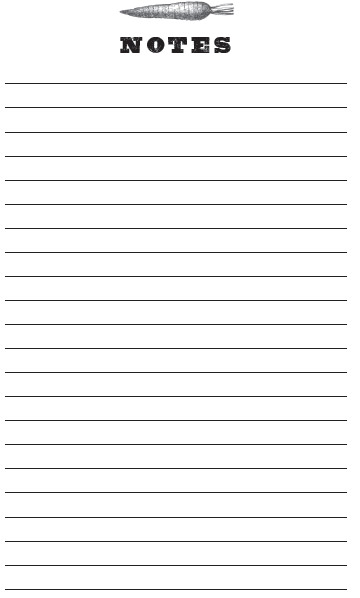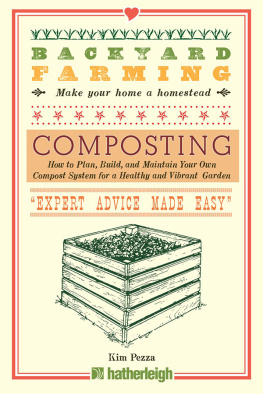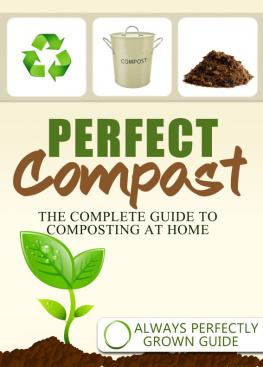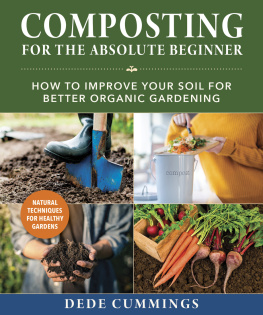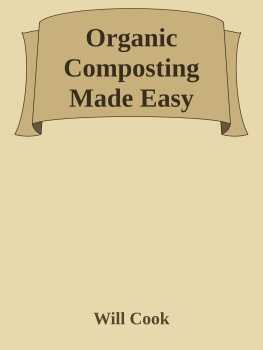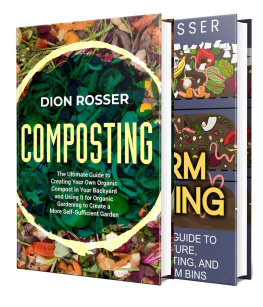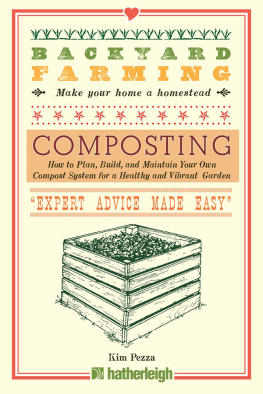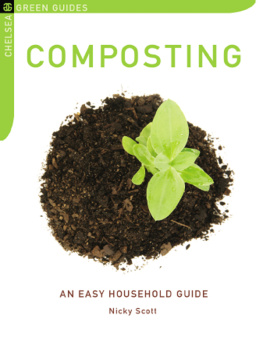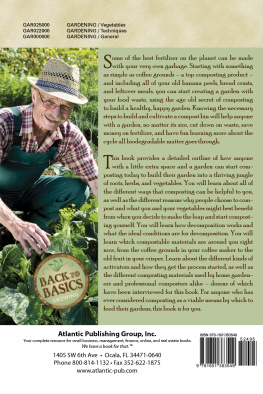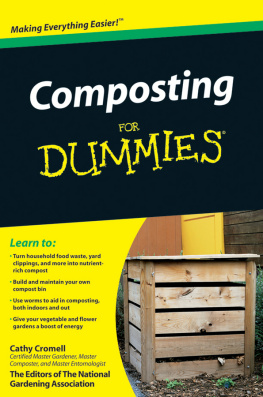
Hatherleigh Press is committed to preserving and protecting the natural resources of the earth. Environmentally responsible and sustainable practices are embraced within the companys mission statement.
Visit us at www.hatherleighpress.com and register online for free offers, discounts, special events, and more.
Backyard Farming: Composting
Text copyright 2015 Hatherleigh Press
Library of Congress Cataloging-in-Publication Data is available upon request.
ISBN: 978-1-57826-587-9
All rights reserved. No part of this book may be reproduced, stored in a retrieval system, or transmitted, in any form or by any means, electronic or otherwise, without written permission from the publisher.
Cover Design and Interior Design by Carolyn Kasper
Printed in the United States
10 9 8 7 6 5 4 3 2 1
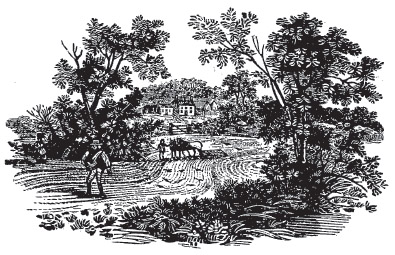
MEET THE EXPERT
Kim Pezza grew up among orchards, muck land, dairy and beef farms, having lived most of her life in the Finger Lakes region of New York State. She has raised pigs, poultry and game birds, rabbits and goats, and is experienced in growing herbs and vegetables. In her spare time, Kim teaches workshops in a variety of areas, from art to making herb butter, oils and vinegars. She continues to learn new techniques and skills and now spends time between her grandparents mid-1800s farm in New York and in Southwest Florida, the first and oldest cattle area in America and origin of the American cowboy.
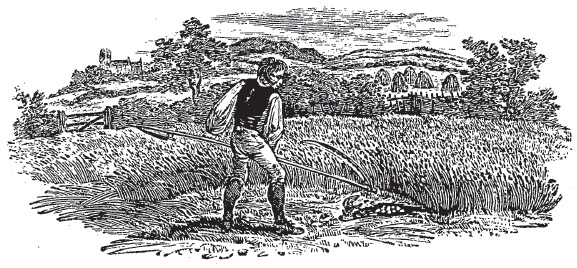

IN CLOSING
C omposting is something that anyone can do, no matter where they live. Not only does it alleviate stress on our landfills, composting also provides us the nutrients needed to rejuvenate our soil, which can easily become exhausted when overused. Whether your garden consists of vegetables, fruits or even just a few flowers, the soil underneath will welcome a jolt of energy from the nutrient rich black gold that all gardeners prize.
Once you have completed your first compost cycle, you will almost certainly be hooked; if you havent done so already, youll soon have your second pile started, counting down the days until your next soil harvest (or worm harvest, for vermiculturists).
While some individuals, towns and cities still need a bit of educationnot only in regards to the benefits of compost, but the process as wellthe ability to compost is worth fighting for. This is an opportunity for those of us who can appreciate the value of compost to shine, taking advantage of these teachable moments to show off the benefits and correct the misconceptions surrounding this beneficial resource.
So start saving that food garbage, and if your friends and family arent composting (and you just cant get them interested), get their scraps as well. But beware: once they see what you end up with, you just might lose out on those extra scraps. You may even have visitors showing up, bearing bags to fill with your rich soil. Go ahead and share; you know where to get more!
Whether you decide to use bins, barrels, heaps or an indoor kitchen compost bucket, composting means youre doing everyone a favor: yourself, the earth, the landfills, and most of all your plants. And once your compost is finally ready...
Enjoy!
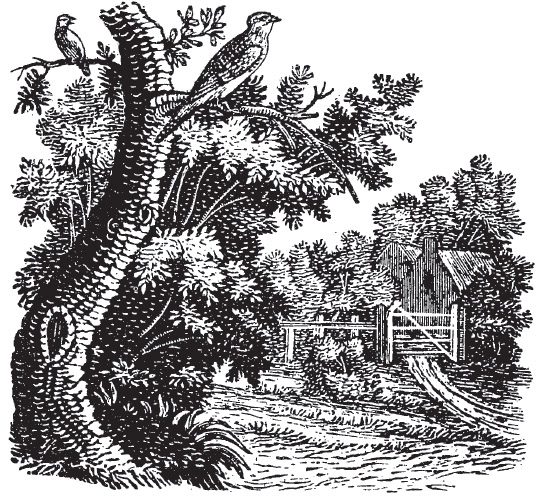

RESOURCES
Online
The Carbon Nitrogen Ratio
www.weblife.org/humanure/chapter3_7.html
A handy chart to assist with figuring your proper ratios.
Another Ratio Chart
www.plantnatural.com/composting-101/c-n-ratio/
Organic Calculator
www.organicsciencellc.com/composting.html
US Mortality and Butcher Waste Disposal Laws
http://compost.css.cornell.edu/mapsdisposal.html
A searchable map of the rules and regulations surrounding US disposal laws as they relate to livestock composting.
Bins
Compost Bin Designs
www.compostguide.com/18-cool-diy-compost-bin-designs/
Tumbler Bin Plans
www.instructables.com/id/compost-bin/
www.motherearthnews.com/diy/compost-tumblers-zmaz79mazraw.aspx
www.instructables.com/id/The-Best-Triple-Compost-Bin/
Choosing the Best Compost Bin
www.motherearthnews.com/organic-gardening/garden-tools-/best-compost-bin-2m0z14fmzmar.aspx
Vermicomposting
www.rodalesorganiclife.com/gardenvermicomposting
Working Worms: How to Make Your Own Worm Farm www.working-worms.com/how-to-make-your-own-worm-farm/
Books
Relf, D., &McDaniel, A. (2000). Composting (Rev. ed.). Blacksburg, Va.: Virginia Cooperative Extension.
Hirrel, S., & Riley,T. (1993). Composting. Fayetteville, Ark: Cooperative Extension Service, University of Arkansas, U.S. Dept. of Agriculture and county governments cooperating.
Composting livestock mortalities. (1997). Place of publication not identified: Ontario Ministry of Agriculture, Food and Rural Affairs.
Insam, H. (2002). Microbiology of composting. Berlin: Springer
Woolnough, M. (2010). Worms & wormeries: Composting your kitchen wasteand more! Preston [England: Good Life Press.
Cullen, M., &Johnson, L. (1994). The urban/suburban composter: The complete guide to backyard, balcony, and apartment composting. New York: St. Martins Press.
Backyard composting: Worm composting bin. (1995). Baton Rouge: Louisiana Cooperative Extension Service.
Cogger, C., & Sullivan, D. (2001). Backyard composting (Rev. Oct. 2001. ed.). Pullman, Wash.: Cooperative Extension, Washington State University.
Dickerson, G. (2000). Vermicomposting. Las Cruces, N.M.: Cooperative Extension Service, College of Agriculture and Home Economics, New Mexico State University.
Payne, B., & Bourgeois, P. (1999). The worm cafe: Mid-scale vermicomposting of lunchroom wastes :A manual for schools, small businesses and community groups. Kalamazoo, MI: Flower Press.
Vermicomposting (Rev: 08/92. ed.). (1992). Ontario Environment.
Ladner, P. (2011). The urban food revolution: Changing the way we feed cities. Gabriola Island, BC: New Society.
Cummings, D. (n.d.). The organic composting handbook: Techniques for a healthy, abundant garden.
Periodicals
Composting: An Urban Treasure.(Brief Article). (2001, September 22). Earth Island Journal.
Spagnoli, J. (1997, June 1). Waste not: Confessions of a backyard composter. New York State Conservationist.
Best, J. (2003, March 22). Compost this magazine! (Living Green.), (composting techniques). OnEarth.
